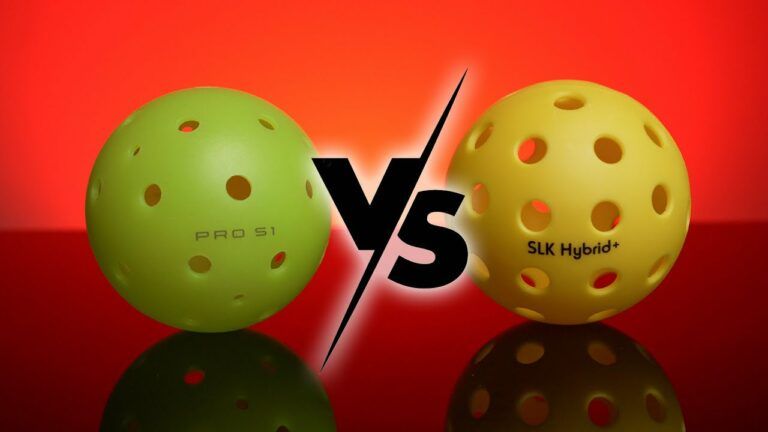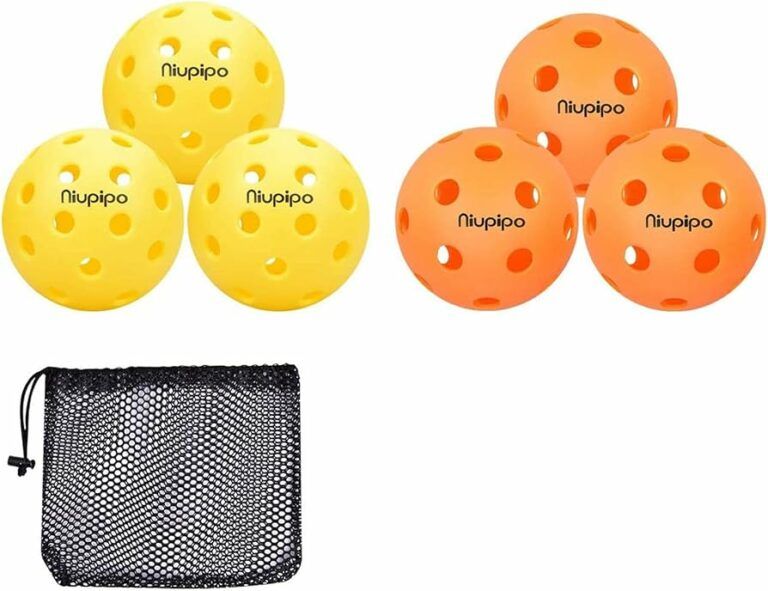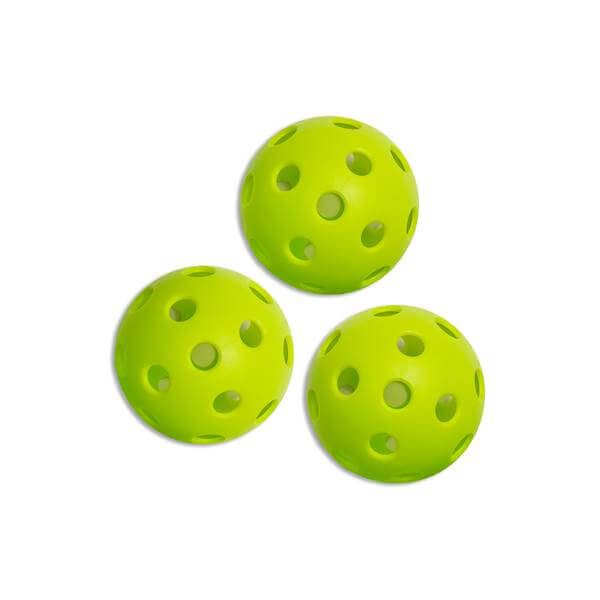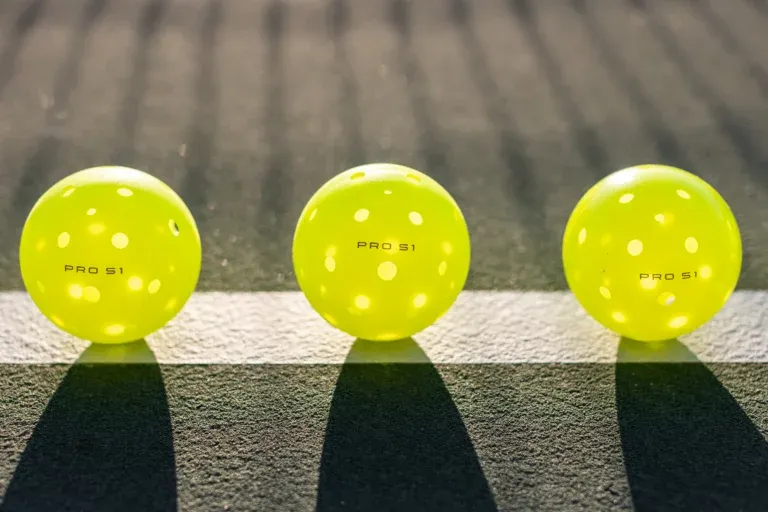Understanding the Basics of Pickleball Balls
As with any sport, having the right equipment can make or break your performance. The basics of pickleball balls extend beyond mere aesthetics; they are deeply rooted in physics and player dynamics. This section will cover the materials used in construction, the purpose of the holes, and the official guidelines set by the USA Pickleball Association, providing a solid foundation for understanding what makes each ball unique.

What are pickleballs made of?
Pickleball balls are fundamentally made of plastic, but the specific type and composition vary significantly between indoor and outdoor varieties. Indoor balls generally utilize a softer plastic that not only allows for better control but also helps reduce noise on impact. This softer material can absorb shock effectively, making it easier for players to execute delicate shots with precision. On the other hand, outdoor balls are crafted from a harder plastic, engineered to withstand tougher conditions while resisting wear and tear from rough surfaces. This difference in composition directly influences their feel, resilience, and gameplay dynamics.
Why do pickleballs have holes?
The holes partitioned into the balls serve a critical function in the aerodynamics and flight stability of the ball. Indoor pickleballs feature 26 larger holes that take advantage of airflow to create a lighter, more responsive ball. This design facilitates precise strokes, allowing for strategic play that is ideal on smooth surfaces like gym floors. Conversely, outdoor balls are designed with 40 smaller holes, strategically positioned to minimize the impact of wind, providing unmatched stability and consistent flight paths in unpredictable outdoor conditions. The nature of the holes not only characterizes the ball but also dictates how players can engage with their game environment

Official USA Pickleball Ball Guidelines
To maintain uniformity and fairness within the sport, the USA Pickleball Association has established specific guidelines regarding equipment. An approved ball must maintain a diameter between 2.87 to 2.97 inches and conform to a weight ranging from 0.8 to 0.9 ounces. These regulations ensure that both indoor and outdoor balls uphold the integrity of competition, enabling fair play across different venues. Familiarity with these standards is essential for players; it empowers them to select appropriate balls that adhere to competitive setups, whether at a friendly match or a professional tournament.
Indoor Pickleballs: Designed for Control and Precision
Indoor pickleballs are meticulously designed to enhance precision and control within the delicate confines of gymnasium settings. They allow players to focus on strategy and finesse as they navigate the court. In this section, we will explore the characteristics of indoor balls, the types of surfaces they are best suited for, and the playing style that thrives when using them.

Indoor Ball Characteristics
The essence of indoor pickleballs lies in their construction. Typically, these balls are composed of a softer plastic that weighs approximately 0.917 ounces, making them slightly lighter than their outdoor counterparts. With 26 larger holes, indoor balls offer a unique advantage by allowing for smoother airflow, which translates to improved spin and control during play. Their softer material significantly reduces noise upon impact, making them ideal for indoor environments where sound levels can turn distracting. This noiseless play creates a more serene ambiance, allowing players to focus intently on game strategies rather than auditory disturbances.
Indoor Court Surfaces
Indoor pickleballs are best utilized on surfaces that promote finesse and control. Common surfaces include hardwood, urethane, rubber, and vinyl courts, each offering a unique playing experience. Hardwood courts are particularly revered for their smoothness and predictable bounce, elements that indoor balls capitalize on. The consistent surface allows players to execute deft shots and engage in longer rallies, facilitating a playstyle centered around skill and precision. Understanding the dynamics of your playing surface is crucial; armed with this knowledge, players can maximize the advantages of indoor balls in various settings.
Playing Style and Benefits of Indoor Balls
When it comes to gameplay, indoor balls ignite a love for strategic play. These balls tend to provide a slower pace and lower bounce, allowing players to engage in thoughtful exchanges and longer rallies. This slower gameplay encourages players to develop their skills in control and finesse, paving the way for a more nuanced understanding of shot selection and placement. As players hone their abilities with indoor balls, they often find that the strategic elements of the game become more pronounced. This controlled setting allows for a communal experience; friends or teammates can enjoy the thrill of competition without the unpredictability associated with outdoor elements.
Outdoor Pickleballs: Built for Durability and Wind Resistance
Outdoor pickleballs are constructed to withstand harsher conditions, ensuring that the game can continue regardless of environmental elements. This section will delve into the unique characteristics of outdoor balls, the surfaces they are designed for, and the aggressive playing style they foster in competitive settings.

Outdoor Ball Characteristics
Outdoor pickleballs are engineered for durability and resilience, employing harder plastic materials, ultimately making them heavier, typically weighing around 0.925 ounces. The construction involves 40 smaller holes carefully designed to combat the effects of wind and other outdoor conditions. This design allows for a more stable flight path, which is critical for maintaining control over the ball’s trajectory when the weather turns blustery. While they might sacrifice some level of finesse compared to indoor balls, outdoor options thrive in fast-paced, dynamic settings where power shots and quick reflexes reign supreme.
Outdoor Court Surfaces
Players often engage with outdoor pickleballs on concrete, asphalt, acrylic courts, or even specialized dedicated pickleball courts. Each of these surfaces presents its own challenges and advantages. For instance, concrete and asphalt are notorious for being rough on equipment; hence, outdoor balls are specifically designed to handle abrasive surfaces and varying temperatures without compromising performance. Furthermore, outdoor courts can often feature irregularities that necessitate a ball capable of bouncing higher and sustaining impacts during intense gameplay. Players familiar with outdoor conditions can customize their playing style, capitalizing on the durability of outdoor balls to unleash their full potential.
Playing Style and Benefits of Outdoor Balls
The character of outdoor pickleballs encourages a more aggressive playing style, suited for players looking to unleash powerful shots and demonstrate quick reflexes. With a faster speed and higher bounce, outdoor balls often create a more energetic and dynamic environment. This fast-paced setting can energize players, fostering excitement and allowing for exciting rallies. Wind resistance plays a crucial role; players must adapt their strategies to account for outdoor conditions, such as adjusting their shot angles to account for gusts. By embracing this dynamic approach, outdoor players often find that their on-court adaptability improves, ultimately enhancing their overall gameplay experience.
Indoor vs Outdoor Pickleballs: Choosing the Right Ball
When it comes to selecting the appropriate ball for your pickleball game, understanding the court surface and environmental factors plays a vital role. This section will explore how to match pickleballs to various surfaces and discuss how outdoor conditions can influence gameplay effectiveness.
Matching Balls to Court Surfaces
Selecting the right ball depends heavily on the type of court being played on. Indoor courts, typically smooth and predictable, are best suited for indoor balls that allow for controlled play. The softer materials of indoor balls provide the necessary characteristics for a smooth, engaging experience. Conversely, outdoor courts’ variability necessitates the use of outdoor balls that can withstand rough terrains. Players should recognize the impacts their chosen surface has on the ball’s behavior; for instance, outdoor courts may diminish the longevity of indoor balls due to surface abrasiveness. Knowing these distinctions allows players to enhance their overall experience, ensuring they are well-matched to the court environment.
The Impact of Weather on Outdoor Pickleball
Weather conditions can significantly influence the performance of outdoor pickleballs, affecting player strategies and shot execution. Wind can alter the trajectory of the ball, requiring players to adjust their shots accordingly; knowing how to navigate these elements is essential for competitive play. Additionally, sunlight can create glare, influencing a player’s focus and shot accuracy. Temperature fluctuations can also affect ball behavior; colder temperatures may lead to reduced bounce, while extreme heat can cause balls to warp or crack. Thus, players are advised to prepare strategically for varying conditions, ensuring they optimize performance across different weather scenarios.
Beyond the Basics: Deep Dive into Pickleball Ball Construction
To truly appreciate the nuances of indoor versus outdoor pickleballs, we need to dive deeper into their construction. The design, materials, and manufacturing processes impart distinct gameplay characteristics that can shape a player’s experience on the court. This section will explore core materials, seam types, and the science behind the hole patterns that define these balls.
Core Materials and Construction
The construction of pickleballs can generally be categorized into two types: single-piece and two-piece designs. Indoor balls predominantly feature single-piece construction, providing a softer touch and responsive feel. This manufacturing method enhances durability while minimizing the likelihood of cracking. Outdoor balls, however, often utilize two-piece designs that aid in merging toughness with performance ability. This choice enhances the outer shell’s durability, ensuring the ball can endure the impact of rough surfaces while maintaining the desired aerodynamics required for competitive play. Understanding these construction methods can empower players to make knowledgeable decisions when selecting the right ball for their needs.
Seam Types and Their Influence
The seam construction of a pickleball can also impact its durability and performance. Indoor balls generally possess seamless designs, enhancing their ability to absorb shock while delivering a precise playing experience. This lack of seams helps maintain the structural integrity of the ball, contributing to a more consistent bounce. In contrast, outdoor balls often use visible seams that enhance aerodynamics, allowing for improved flight paths. This strategic choice ensures that outdoor balls remain stable in unpredictable conditions, which is essential for success in dynamic, fast-paced matches.
The Science Behind Hole Patterns
As previously noted, the number and size of holes in each ball significantly contribute to their performance. The hole size influences airflow, which in turn affects the aerodynamics of the ball. Larger holes, such as those found on indoor balls, permit greater airflow, promoting a responsive touch and precision. Conversely, smaller holes in outdoor balls provide an aerodynamic advantage that helps combat the effects of wind, maintaining stability and control during play. Understanding this design science can aid players in predicting ball behavior and enhancing their strategy when taking shots, ultimately impacting their overall game success.
Pickleball Ball Durability and Lifespan: Maximizing Your Investment
The longevity of your pickleball equipment is an essential consideration for any player, impacting performance and overall enjoyment. This section will scrutinize the factors that affect ball durability, recognized signs of wear, and how proper care can extend the lifespan of your pickleballs.
Factors Affecting Durability
Numerous factors play a role in the durability of pickleballs, from their material and construction to environmental conditions and court surface types. Typically, outdoor balls are designed to withstand tougher conditions, but their lifespan can diminish in extreme temperatures. Conversely, indoor balls tend to wear out more rapidly when subjected to rough surfaces. It is essential for players to understand the relationship between their playing conditions and the persistent longevity of their equipment. By being mindful of these factors, players can optimize their selection and usage of pickleballs to ensure they get maximum value from their investment.
Signs of Wear and Tear
As pickleballs undergo usage, they incur wear and tear that can alter performance. Key signs to watch for include visible cracking, deformities, soft spots, or splitting along the seams. When such symptoms appear, they can significantly diminish a ball’s flight characteristics, ultimately affecting the game. Regular inspections of your equipment can help players determine when it is time to replace their balls. By cultivating this proactive approach, players can consistently perform at their best without interruptions due to deteriorating equipment.
Cleaning, Storage, and Maintenance
Proper care and maintenance of pickleballs are essential in maximizing their lifespan. Regular cleaning, especially after outdoor play, can ensure that dirt and debris do not accumulate and wear down the ball’s surface. Storing balls in a cool, dry place away from direct sunlight is also crucial; temperature extremes can warp or crack pickleballs over time. Following these simple maintenance tips extends their usability, ensuring players can enjoy their balls for as long as possible while preserving performance quality.
Debunking Myths: Can You Use Indoor Balls Outdoors?
A common question among pickleball enthusiasts is whether indoor balls can be effectively used outdoors. While some might argue for versatility, this section will illuminate why this practice is generally discouraged while addressing potential exceptions.
Why It’s Not Recommended
While indoor balls may seem appealing for outdoor use due to their lightweight nature, they are ill-suited for demanding environments. Their softer composition makes them vulnerable to impacts, which can lead to cracking, particularly on rough surfaces. Furthermore, the larger hole design can result in erratic flight patterns in windy conditions, ultimately undermining players’ control and performance. Therefore, players are highly discouraged from using indoor balls outdoors; the risks involved outweigh any perceived benefits.
Exceptions and Special Considerations
While using indoor balls outdoors is generally ill-advised, unique situations may arise where players find it suitable to make exceptions. For instance, in hybrid courts specifically designed to accommodate various play conditions, a player might choose to experiment with indoor balls. However, this should be done understanding the potential trade-offs in performance and durability. Players are advised to prioritize the ball type recommended for specific environments to ensure their shot precision and gameplay enjoyment remain optimal.
The Auditory Experience: How Sound Affects Pickleball Play
The auditory dimensions of pickleball can dramatically influence both player engagement and enjoyment on the court. This section will explore how sound dynamics shift between indoor and outdoor environments, and the implications they carry for different players.
Indoor Acoustics
Inside the enclosed walls of a gym, sounds tend to echo and reverberate, creating a unique auditory landscape for players. The impact of the ball on different surfaces generates distinct sound profiles that can influence player focus and reactions. While the controlled environment allows for a quieter playing experience, the acoustics can also amplify the intensity of shots, creating a thrilling atmosphere for competitors. Players with auditory sensitivities may be particularly affected by sound levels; understanding the interaction between sound and gameplay can enable them to adapt accordingly.
Outdoor Sound Dynamics
Contrary to the enveloping sounds of indoor play, outdoor environments introduce a myriad of auditory elements: wind, surrounding nature, and even distant city sounds contribute to the auditory experience. This open backdrop may create more distractions, forcing players to concentrate harder and adjust their focus. Understanding how sound can impact gameplay is crucial, especially for those who thrive on auditory cues. Players need to develop strategies to mitigate distractions stemming from outdoor play dynamics, emphasizing mental resilience to enhance performance.
Considerations for Players with Auditory Sensitivities
For players sensitive to noise levels, both indoor and outdoor play can present distinct challenges. Those with pronounced auditory sensitivities may face disruptions from the sound of impact or environmental noise, which can hinder their concentration and performance. Utilizing earplugs or seeking out quieter playing environments can help mitigate such challenges, allowing for improved engagement with the game. Creating a tailored playing experience can significantly elevate enjoyment and performance, reflecting the player’s unique needs and preferences.
Top Pickleball Ball Recommendations: From Beginners to Pros
Selecting the right pickleball for your skill level can help maximize your overall playing experience. This section will explore factors to consider when making a choice and recommend specific brands and models for various skill levels.
Factors to Consider When Choosing a Ball
When determining which pickleball to choose, several aspects come into play. Players should consider factors such as price, performance characteristics, durability, and personal preference. For beginners, affordability might be paramount, while advanced players may prioritize performance and specific ball characteristics that align with their playing style. Understanding the trade-offs within these factors helps players make informed choices that align with their individual goals.
Indoor Ball Recommendations by Skill Level
- Beginner: A lightweight indoor ball like the Onix Fuse G2 would be a suitable starter; its softer feel and reduced noise make it ideal for those just learning the game.
- Intermediate: Players at this level may enjoy the Gamma Photon, offering enhanced control and spin ability that aids in developing skills further.
- Advanced: The Selkirk Pro S1 stands out for its precise shot accuracy and performance while retaining excellent bounce characteristics, making it ideal for competitive gameplay.
Outdoor Ball Recommendations by Skill Level
- Beginner: The Dura Fast 40 is popular among novices, providing excellent durability while maintaining a consistent bounce suited for outdoor play.
- Intermediate: The Franklin X-40 offers a good blend of toughness and performance, ideal for players looking to elevate their game.
- Advanced: The Vulcan VPro Flight is a top choice for professionals due to its incredible flight stability and responsiveness, providing the precision needed during intense matches.
Insights from Ball Manufacturers
Engaging with experts from leading pickleball manufacturers can provide additional insights into selecting the right equipment. Many brands continuously innovate to enhance performance and durability. The ongoing dialogue within the industry encourages players to stay informed about new technologies and advancements that can incrementally improve their game experience.
Advanced Pickleball Ball Strategies: Elevate Your Game
As players advance in skill level, understanding ball dynamics can enhance performance and gameplay strategies. In this section, we will explore how to manipulate spin, choose balls suited to various play styles, and reflect on the historical evolution of pickleball balls.
Manipulating Spin and Ball Flight
Advanced players often leverage their understanding of ball dynamics to manipulate spin and trajectory effectively. By understanding how the hole patterns and construction affect flight characteristics, players can create spin variations that manipulate their opponents’ responses. The key lies in combining shot power with an understanding of how wind can call for adaptive shots. Mastering these techniques can elevate a player’s game, providing a competitive edge.
Choosing Balls for Different Game Styles
Different playing styles call for specific ball characteristics that match the player’s approach. Power players may prefer outdoor balls that can withstand and enhance aggressive shots, while control players might gravitate towards indoor balls that allow for more finesse. Understanding the dynamic interplay between playing style and ball characteristics can guide players in selecting the right equipment that aligns with their strategy and gameplay preferences.
The Evolution of Pickleball Balls: A Historical Perspective
The journey of pickleball balls reflects the sport’s growth and changing demands. Early iterations were simplistic, leading to slow-paced games; however, modern technology has brought forth innovations that enhance performance attributes like speed, spin, and durability. As the sport continues to evolve, so do the tools of play, giving players the opportunity to benefit from advancements that have become integral to competitive gameplay.
Join the Pickleball Ball Conversation
The beauty of pickleball lies not just in the gameplay, but also in the engaging community that surrounds it. Players are encouraged to share their experiences, recommendations, and personal insights related to ball selection, playing environments, and techniques. By fostering dialogue, players can collectively enhance their understanding of the sport and create a richer experience for all involved.
Conclusion
Understanding the critical differences between indoor and outdoor pickleballs equips players with the knowledge necessary to optimize their gameplay experience. From distinguishing characteristics such as hole designs and materials to the impact of court surfaces and weather conditions, each aspect plays a crucial role in determining which ball to choose. As players navigate the dynamic world of pickleball, armed with these insights, they will undoubtedly enhance their strategic and tactical approach to the game. Whether engaging in competitive matches or honing their skills, the right choice of equipment can lead to a more fulfilling and enjoyable experience on the court.








